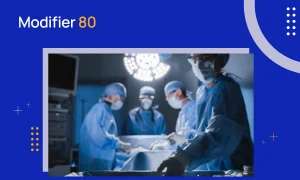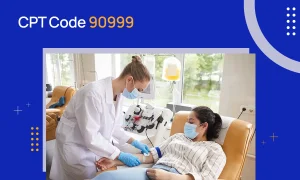Dermatology is not all about achieving spotless skin and shiny hair. It is also a complex specialty that deals with skin and hair health by diagnosing and treating various conditions. Besides, billing for these services is not easy at all. Dermatologists often struggle with an unsteady cash flow. The key cause is failure to fulfill documentation requirements for simple lesion removals.
Luckily, this guide will help you master billing for CPT code 17000, which is a common procedure for lesion destruction. Here’s a glimpse into what it covers: detailed descriptor explanation, real-world clinical scenarios, a list of applicable modifiers, and reimbursement guidelines.
So, do not stop and continue reading!
CPT Code 17000 – Description
CPT code 17000 covers the removal of a premalignant lesion using different techniques. These may include electrosurgery, cryosurgery, chemosurgery, and others. Besides, you can only report this code for the destruction of the first or only lesion. Here’s what ‘first’ and ‘only’ mean:
- First: The patient has five actinic keratosis on the face. You removed all, but you can report only 1 unit of CPT 17000 for the first removal. That is, report specific units of the add-on code 17003 to bill for the subsequent removals.
- Only: The patient has only one premalignant lesion on the dorsal aspect of the left hand. You destroyed it and billed 1 unit of 17000.
For context, you can find a brief explanation of the destruction techniques mentioned in the CPT code 17000 descriptor:
- Electrosurgery: This method employs electrical current to generate heat within the tissue to destroy the lesion.
- Cryosurgery: It utilizes extreme cold, such as liquid nitrogen, to freeze and rupture the targeted cells.
- Chemosurgery: It involves using the controlled application of a caustic chemical agent, such as concentrated acid, directly to the lesion.
Appropriate Use Cases for CPT Code 17000
Say goodbye to confusion and gain a better understanding of where CPT 17000 applies with the following real-world clinical scenarios:
Solitary Actinic Keratosis on the Forehead, Cryosurgery
Picture a 63-year-old female patient who visits the dermatology clinic for a scheduled annual full-body skin examination. During the encounter, the dermatologist identifies a single, pink-to-red, scaly, and rough lesion on the patient’s forehead (left side) and confirms actinic keratosis, or AK for short, diagnosis.
Therefore, the dermatologist counsels the patient about the premalignant nature of the lesion. He then opts for cryosurgery after taking the patient’s consent. As a result, liquid nitrogen is applied with a cotton swab to destroy the single lesion.
Here, CPT code 17000 applies.
Single Actinic Keratosis on the Hand, Electrosurgery
Consider a 77-year-old male patient with a history of extensive sun exposure. He visits the dermatology clinic and complains about a persistent, hyperkeratotic papule on the dorsal aspect of his right hand. Emollients failed to resolve the issue.
The dermatologist examines it and confirms an AK diagnosis. He opts for electrosurgery to destroy the lesion. Thus, using electric current, followed by light curettage, the dermatologist ensures complete removal of the single lesion.
Report CPT code 17000 to bill for the services.
Isolated Actinic Keratosis on the Lower Lip Vermillion, Chemosurgery
Imagine a 50-year-old female patient comes to the dermatology clinic with a firm, chronic scaling lesion. It is isolated to the vermillion border of the lower lip.
The dermatologist confirms the clinical diagnosis as actinic keratosis. However, he chooses a controlled application of a concentrated chemical agent for destruction, given the sensitive location of the lesion.
Therefore, the provider carefully applies the chemical directly to the lesion. He also monitors the tissue response until adequate frosting is observed.
Here, CPT code 17000 applies.
Modifiers to Append with CPT Code 17000
Appropriately append modifiers to ensure coding specificity and avoid leaving money on the table. Listed below are some modifiers that billers generally append when billing for lesion destruction, represented with CPT 17000:
Modifier 24
What happens when the same physician renders an unrelated E/M service to the same patient during the post-operative period of CPT code 17000? You append modifier 24 to the E/M code to avoid unnecessary bundling and ensure accurate reimbursements.
Modifier 25
Note that CPT code 17000 has a global period of 10 days. Thus, in case you provide any significant and distinct E/M service during this period that you believe must be reimbursed separately, append modifier 25. Otherwise, billing for E/M services without this modifier will result in non-payment or denial.
Modifier 51
If the physician performs another/secondary procedure during the same surgical session as the lesion removal, report the secondary service with modifier 51. The payer will reimburse the primary service, the one with a higher fee, at a 100% rate, and the secondary service at 50% value.
Reimbursement Guidelines for CPT Code 17000
Stop revenue leakage due to constant denials on your lesion removal claims by following these essential billing guidelines:
Demonstrate Medical Necessity
If you want to receive the rightful reimbursement, then you must prove the clinical necessity of the removal of the premalignant lesion. Here’s what you need to include while submitting your claim against CPT code 17000:
- Clearly states that the lesion is premalignant. Besides, accurately include the diagnosis code, e.g., L57.0 for actinic keratosis.
- Highlight the clinical indication (the reason) that led to the lesion destruction. For example, it was a growing lesion, a symptomatic lesion, the physician’s diagnosis suggested progression to malignancy, etc.
- Do not forget to include the site-specific issue. For example, sun-exposed areas like the face and arms, or AK on the hands and feet.
Fulfill Documentation Requirements
Complete documentation is essential to increase your chances of getting paid on the first try. Thus, your documentation for billing CPT code 17000 must have the following:
- Explicitly state that you have removed the first or only premalignant lesion.
- Include the specific ICD-10 diagnosis code.
- Precisely specify the site of the lesion, e.g., left cheek.
- Describe the technique utilized for the destruction of the lesion, i.e., chemosurgery, cryosurgery, electrosurgery, or others.
Do Not Report CPT Code 17000 For More Than One Lesion
As discussed earlier, CPT 17000 covers the destruction of the first or only lesion. Simply put, you cannot report more than one unit of it for multiple lesion destructions.
So, what can you do instead? You can use the following more specific codes:
- CPT Code 17003: Bill it for destroying 2nd through 14th lesions in a single encounter. (One unit for each additional lesion).
- CPT Code 17004: Report it for removing 15 or more lesions in a single encounter. (Bill only one unit without 17000 or 17003).
Final Thoughts on CPT Code 17000
With everything that we discussed in this guide, we can confidently conclude that billing for lesion destruction is not simple. But with this guide as your go-to resource, hopefully, you will be able to navigate the billing requirements easily.
However, if you still stumble and trigger denials on your CPT code 17000 claims? You can outsource dermatology billing services to professionals like NeuraBill. Outsourcing will help you eliminate denials, reduce audit risks, slash overhead costs, and ensure revenue optimization.



